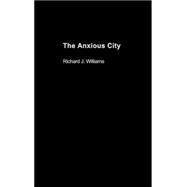The Anxious City: British Urbanism in the late 20th Century
, by Williams,Richard J.- ISBN: 9780415279260 | 0415279267
- Cover: Hardcover
- Copyright: 12/17/2004
In the western world, cities have, arguably, never been more anxious: realistic anxieties about personal safety, and metaphorical anxieties about the uncertain place of the city in culture are the small change of journalism and political debate. Cities have long been regarded as problems, in need of drastic solutions. In this context, the contemporary revival of city centers is remarkable. But in a culture that largely fears the urban, how can the contemporary city be imagined? How is it supposed to be used or inhabited? What should it look like? What should be its purpose? Which existing forms of urban life might serve as models for a new city? Taking England since WW2 as its principal focus, this provocative and original book considers the western city at a critical moment in its history. Historically among the most urbanized of countries, England is an extraordinary urban laboratory. The energy and thoroughness with which its cities have been transformed in the 1990s have lessons for urbandevelopment everywhere. The Anxious Cityexamines the problem of the contemporary city through a series of detailed case studies: Poundbury, Milton Keynes, Liverpool's Albert Dock redevelopment, Trafalgar Square, Canary Wharf, the Great Court of the British Museum, and central Manchester after the 1996 IRA bomb. It deals with some broader cultural phenomena too: the continuing attraction of picturesque aesthetics, and the lure of southern European urbanism (exemplified by the RIBA's canonization of Barcelona) and the complex, contradictory relationship between urbanism in England and the USA. The experience of these places, the book argues, shows a culture where the idea of the city remains contested: the frantic redevelopment of city centers in the 1990s represented one vision of the city - the city of spectacular consumption, competing in some imaginary urban race with other world cities. But such development took place against continuing suburbanization and sprawl. In spite of all thebuilding works, the city was still being worked out This book is a cultural history that will be essential reading for anyone interested in the recent history of urban life. It argues that the contemporary city is uniquely anxious, caught between nostalgia for the past, and uncertainty about the future. At a crucial moment in the history of the city, it cuts through the urbanistic propaganda spread by architects and politicians. This unique and challenging study will be of interest to students and practitioners alike.






